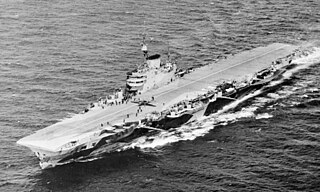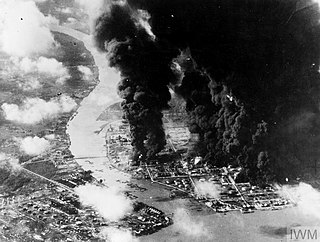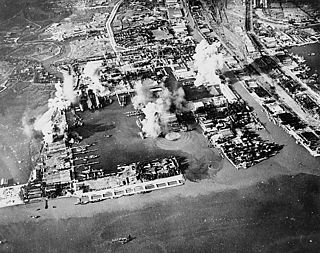Order of battle
The naval order of battle for the operation consisted of two forces: Force 67, the strike force, and Force 69, the oiler group. The commander, Admiral Philip Vian, had his flag aboard the aircraft carrier HMS Indomitable (carrying 857, 1839 and 1844 Naval Air Squadrons). Also in Force 67 were the carrier Illustrious (carrying 854, 1830 and 1833 Naval Air Squadrons), the cruisers Argonaut, Black Prince and Newcastle, and the destroyers Kempenfelt, Wakeful, Wessex, Whirlwind and Wrangler. The oiler group comprised RFA Wave King and the destroyers Wager and Whelp.
The strike force departed from Trincomalee on 17 December, and met Force 69 the next day (18 December). Argonaut, Black Prince and the destroyers of Force 67 refuelled. Undetected, the fleet reached the flying-off position, north of Diamond Point, in the early morning of 20 December. The aerial order of battle consisted of a strike force and an escort force. For the former, Indomitable supplied twelve and Illustrious sixteen Grumman TBF Avengers, each with four 500-lb bombs, and Illustrious supplied a further four Vought F4U Corsairs, each with two 500-lb bombs. The strike leader was Lieutenant Commander W. Stuart. Among the escorts, top cover was provided by eight Grumman F6F Hellcats from Indomitable, middle cover by twelve Corsairs from Illustrious, and close cover by a further eight Hellcats from Indomitable.
Operation
At the flying-off position, low clouds and heavy squalls reduced visibility, prompting Vian to postpone the launch twenty minutes. The operation finally began at 0636. One of Indomitable′s Avengers crashed into the sea after takeoff, but its crew escaped unscathed. The other Avengers and the escort force departed from the fleet at 0715, and the strike Corsairs took off shortly after. The strike force ran into a barrier of clouds as they approached the Sumatran coast. Strike Leader Stuart advanced through a gap in the clouds to inspect the target but was unable to locate it. The strike was diverted to the secondary target, Belawan Deli, where the weather was little better.
The Avengers bombed the wharves from 1500 feet, while the Corsairs strafed the fuel storage tanks and warehouses in the town. A train was also hit at nearby Kuala Simpang. Two of the Corsairs became lost and strafed a large storage tank at either Pangkalan Brandan or Pangkalan Susu. The defences of Belawan Deli were unprepared: the anti-aircraft artillery was ineffective and no fighters were put in the air, although one Mitsubishi Ki-21 was surprised and downed by a Hellcat. The raid ended in chaos, with complete loss of radio discipline. The strike force and escorts rendezvoused just beneath the clouds. Lieutenant Commander W. J. Mainprice had to form up his squadron (No. 854) and lead them back on his own initiative because of the "radio bedlam". All 55 aircraft returned safely and the four Corsairs landed by 1050, and the force retired.
Aftermath
On the afternoon of the attack, a Japanese radio message was intercepted: "Am closing down now, will call you later." At the suggestion of Captain C. E. Lambe of Illustrious, eight of his Corsairs and eight Hellcats from Indomitable were dispatched for a low-level sweep over the airfields at Sabang and Oleelhoe, the port of Kota Raja. No Japanese aircraft were spotted, either on the ground or in the air. Force 67 had returned to Trincomalee by 22 December.
Despite the lack of opposition met, Operation Robson was considered a failure on account of the bad weather and the lack of radio discipline. The subsequent operations of Outflank—Lentil and Meridian—engendered a much greater response from the Japanese and concomitant British losses.

HMS Victorious was the third Illustrious-class aircraft carrier after Illustrious and Formidable. Ordered under the 1936 Naval Programme, she was laid down at the Vickers-Armstrong shipyard at Newcastle upon Tyne in 1937 and launched two years later in 1939. Her commissioning was delayed until 1941 due to the greater need for escort vessels for service in the Battle of the Atlantic.

HMS Illustrious was the lead ship of her class of aircraft carriers built for the Royal Navy before World War II. Her first assignment after completion and working up was with the Mediterranean Fleet, in which her aircraft's most notable achievement was sinking one Italian battleship and badly damaging two others during the Battle of Taranto in late 1940. Two months later the carrier was crippled by German dive bombers and was repaired in the United States. After sustaining damage on the voyage home in late 1941 by a collision with her sister ship Formidable, Illustrious was sent to the Indian Ocean in early 1942 to support the invasion of Vichy French Madagascar. After returning home in early 1943, the ship was given a lengthy refit and briefly assigned to the Home Fleet. She was transferred to Force H for the Battle of Salerno in mid-1943 and then rejoined the Eastern Fleet in the Indian Ocean at the beginning of 1944. Her aircraft attacked several targets in the Japanese-occupied Dutch East Indies over the following year before Illustrious was transferred to the newly formed British Pacific Fleet (BPF). The carrier participated in the early stages of the Battle of Okinawa until mechanical defects arising from accumulated battle damage became so severe she was ordered home early for repairs in May 1945.

HMS Indomitable was a modified Illustrious-class aircraft carrier built for the Royal Navy during World War II. Originally planned to be the fourth of the class, she was redesigned to enable her to operate more aircraft, 48 instead of 36. A second hangar was added above the original, raising the flight deck by 14 feet (4.3 m), although the hangar-side armour had to be reduced to compensate. The lower hangar was made shorter than the upper hangar due to the need for extra workshops and accommodation to support the added aircraft.

HMS Speaker (D90), a Ruler-class escort carrier, based on a "C3" hull, was originally the Bogue-classUSS Delgada (AVG/ACV/CVE-40), which was transferred to the United Kingdom under the Lend-Lease program.

HMS Formidable was an Illustrious-class aircraft carrier ordered for the Royal Navy before the Second World War. After being completed in late 1940, she was briefly assigned to the Home Fleet before being transferred to the Mediterranean Fleet as a replacement for her crippled sister ship Illustrious. Formidable's aircraft played a key role in the Battle of Cape Matapan in early 1941, and they subsequently provided cover for Allied ships and attacked Axis forces until their carrier was badly damaged by German dive bombers in May.

HMS Indefatigable was one of two Implacable-class aircraft carriers built for the Royal Navy (RN) during World War II. Completed in 1944, her aircraft made several attacks that year against the German battleship Tirpitz, inflicting only light damage; they also raided targets in Norway. The ship was transferred to the British Pacific Fleet (BPF) at the end of the year and attacked Japanese-controlled oil refineries in Sumatra in January 1945 before joining the American forces in March as they prepared to invade the island of Okinawa in Operation Iceberg. Indefatigable and the BPF joined the Americans in attacking the Japanese Home Islands in July and August. Following the end of hostilities she visited ports in Australia, New Zealand and South Africa.

The British Pacific Fleet (BPF) was a Royal Navy formation that saw action against Japan during the Second World War. It was formed from aircraft carriers, other surface warships, submarines and supply vessels of the RN and British Commonwealth navies in November 1944.

HMS Euryalus was a Dido-class cruiser of the Royal Navy. She was laid down at Chatham Dockyard on 21 October 1937, launched on 6 June 1939, and commissioned 30 June 1941. Euryalus was the last cruiser built at the dockyard.

Operation Cockpit was an Allied attack against the Japanese-held island of Sabang on 19 April 1944. It was conducted by aircraft flying from British and American aircraft carriers and targeted Japanese shipping and airfields. A small number of Japanese ships and aircraft were destroyed, and one American aircraft was lost. While the attack was successful tactically, it failed to divert Japanese forces from other areas as had been hoped.

Operation Inmate was an attack by the British Pacific Fleet against Japanese positions on Truk Atoll in the central Pacific Ocean during the Second World War. The attacks against the isolated islands on 14 and 15 June 1945 were conducted to provide combat experience for the aircraft carrier HMS Implacable and several of the fleet's cruisers and destroyers ahead of their involvement in more demanding operations off the Japanese home islands.

Operation Meridian, also known as the "Palembang Raids" was part of a series of British air attacks directed at Japanese-held oil refineries near Palembang on Sumatra during the Second World War, Meridian had two phases: Meridian I on 24 January 1945 and Meridian II on 29 January. As a result, the critical aviation fuel output of the plants at Palembang was reduced by seventy-five percent.

Operation Transom was an attack by Allied forces against the Japanese-occupied city of Surabaya on the Indonesian island of Java during World War II. Conducted by the British-led Eastern Fleet, the operation took place on 17 May 1944 and involved American and British carrier-based aircraft bombing the city's docks and an oil refinery. An American torpedo bomber was shot down, and two British torpedo bombers were lost in accidents.

HMS Wessex was one of eight W-class destroyers built for the Royal Navy during World War II. Completed in 1944, the ship spent most of the war assigned to the Eastern and Pacific Fleets. She screened British aircraft carriers as their aircraft attacked targets in the Japanese-occupied Nicobar Islands, the Dutch East Indies and Okinawa.

Operation Lentil (Sumatra) was an air raid by British carrier-based aircraft on oil installations at Pangkalan Brandan, an important centre for Indonesian oil production on Sumatra on 4 January 1945. It was part of the larger Operation Outflank, and its aim was to disrupt fuel supplies to Japanese forces in the Pacific.

HMS Whelp was one of eight W-class destroyers built for the Royal Navy during the Second World War. Completed in 1944, the ship spent most of the war assigned to the Eastern and Pacific Fleets. She screened British aircraft carriers as their aircraft attacked targets in the Japanese-occupied Nicobar Islands, the Dutch East Indies, Formosa and near Okinawa. Whelp was present at the Japanese surrender in Tokyo Bay in 1945 and later in Hong Kong. She was paid off in January 1946 and went into reserve.

Ronald Cuthbert Hay, was a British naval aviator and the only Royal Marine fighter ace. He joined the Royal Marines in 1935 and then served as an aviator with the Fleet Air Arm. In 1940 he joined 801 Naval Air Squadron flying the two seater Blackburn Skua on HMS Ark Royal for the Norwegian campaign, claiming his first victory on his first operational flight. He took part in operations covering the evacuation of the British Expeditionary Force from the Dunkirk beaches. Flying the Fairey Fulmar, he joined 808 Naval Air Squadron during the Battle of Britain.

Operation Banquet was a British naval operation in the Second World War, commanded by Rear Admiral Clement Moody. The objective was to bomb Japanese positions in and around Padang, on the south-western coast of Sumatra, in Indonesia, on 24 August 1944. The primary targets of the attack, Padang airfield, the Indaroeng cement works, and the harbor facilities and shipping at Emmahaven were hit.

Operation Goodwood was a series of British carrier air raids conducted against the German battleship Tirpitz at her anchorage in Kaafjord in occupied Norway during late August 1944. It was the last of several attacks made by the Home Fleet during 1944 which sought to damage or sink Tirpitz and thereby eliminate the threat it posed to Allied shipping. Previous raids on Kaafjord conducted by Fleet Air Arm aircraft had involved only one air attack; in Operation Goodwood several attacks were made in a single week. The Royal Navy hoped that these raids would wear down the formidable German defences.

For the April 1945 invasion of Okinawa, the Allies assembled the most powerful naval force in history. Since the few remaining capital ships of the Imperial Japanese Combined Fleet had been sunk or otherwise put out of action at the Battle of Leyte Gulf, the Allies were effectively unopposed in terms of major surface vessels; a single mission consisting of the superbattleship Yamato and a few escorts was undertaken, but the task force did not get within 200 nautical miles of the invasion area. The main Japanese naval opposition within the invasion area came from hundreds of Imperial Japanese Navy Shin'yō-class suicide motorboats and Maru-Ni Imperial Japanese Army attack boats.


















